
|
Sale 82
The Fall Manuscript, Collectibles, Stamp and Space Memorabilia Auction
| The Claude Harkins Collection of Americana |
| |
| |
| Lot |
Photo |
Description |
Realized |
Lot 468 |
 |
"Examining the Flag" - Oil on Canvas by Jennie Brownscombe. 30¼ x 39¼", early 20th century, signed at lower left. Framed to 42½ x 52". Commemorating Betsy Ross's mythical presentation of the first flag to George Washington, who is seated and holds part of the flag. George Ross, Betsy's uncle and a Signer of the Declaration of Independence from Pennsylvania, stands beside Washington. Robert Morris, known as the financier of the Revolution, is seated at Washington's left and holds a lorgnette to better examine the flag. A young girl stands beside Betsy and a young woman sews by the fireplace.
Jennie Brownscombe (1850-1936) was an American painter, designer, etcher, commercial artist and illustrator. She studied at the National Academy of Design in New York City, 1878-81, 1872-75; The Art Students League of New York, 1875-78; and School of Design for Women, The Cooper Union for the Advancement of Science and Art, New York City, 1871-72. She painted genre paintings, mostly in oils and watercolor, many of revolutionary and colonial American history, including "First Thanksgiving at Plymouth." Her paintings are noted for their realistic romantic figures and beautiful color. More than 100 of her works were reproduced by etching, engraving and photograving, often appearing on calendars and in magazines. She was the Norman Rockwell of her time.
This painting was on loan to Winterthur Museum from October 2, 2010 to January 2, 2011 as part of the exhibit: "Betsy Ross. The Life Behind the Legend." 2. In 2009, it was part of a joint exhibition by the U.S. Embassy in Abu Dhabi and the U.S. Consulate General in Dubai, highlighting the history of the American flag as a national symbol. The painting has also been exhibited at the Herbert Hoover Library (2002) and at the James Michener Art Museum in Doylestown, Pennsylvania.
Some professional restoration by the Western Center for the Conservation of Fine Arts in Denver, Colorado. Details available upon request.
Buyer responsible for third party shipping. Call to make arrangements.
Estimated Value $15,000 - 25,000.
Ex. The Claude Harkins Collection of Americana; Christie's East, Jan. 12, 1999, Lot 28.
View details and enlarged photo
| Realized
$45,600 |
Lot 469 |
 |
Painting of the Ship "Delaware" of Philadelphia, c. 1793. Watercolor and graphite on laid paper, American School 18th/19th century, 19 x 25" (sight); framed to 25 x 31". A handwritten note taken from the verso reads, "Ship Delaware owned by Jacob Shoemaker. She carried cargo to India, and brought other cargo. Jacob Shoemaker attended to the trading, and was supercargo. This ship was given to Elizabeth Pearsall Frazier by her father, William Pearsall 1893." William Pearsall (1836-1916) was the grandson of Jacob Shoemaker. The Delaware flies a flag with 13 stars in the Great Star pattern and 13 stripes, seven red and six white.
Jacob Shoemaker was a partner with John James in the mercantile firm of James & Shoemaker at 25 N. Water Street in Philadelphia; the Delaware was commanded by Captain James Art. On Nov. 25, 1793, Edmond Charles Genet, Minister Plenipotentiary of France, wrote to Secretary of State Thomas Jefferson alleging that French refugees in Philadelphia and Baltimore were preparing to embark on the ship Delaware and the schooner Betsey to launch military expeditions against St. Domingo. President George Washington ordered Secretary of War Henry Knox to have the governors of Pennsylvania and Maryland investigate this matter. Nathaniel Falconer, Master Warden of the port of Philadelphia, wrote to Pennsylvania Governor Thomas Mifflin on Nov. 29, 1793, that Jacob Shoemaker had assured him that the Delaware was bound for Cape St. Nicolas Môle and that only one passenger had signed up so far. Shoemaker and Captain Art were instructed to bring to Falconer any Frenchman who signed up as a passenger so that Falconer could ascertain the purpose of his voyage.
On Nov. 30, 1793, Jefferson wrote to Genet: "…Our country is open to all men, to come and go peaceably, when they choose. And your letter does not mention that these emigrants meant to depart armed and equipped for war. Lest, however, this should be attempted, the Governors of the states of Pennsylvania and Maryland are requested to have particular attention paid to the vessels named in your letter, and to see that no military expedition be covered or permitted under cover of the right which the passengers have to depart these States…."
Estimated Value $8,000 - 12,000.
Ex. The Claude Harkins Collection of Americana; Samuel T. Freeman, 11/14/2012, lot 619.
View details and enlarged photo
| Realized
$2,520 |
Lot 470 |
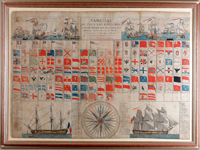 |
Rare French Print of the Sea Flags of All Nations, Paris, 1798. "Tableau de Tous les Pavillons que l'on Arbore Sur les Vaisseaux Dans les Quatre Parties du Monde Où se Trouve le Pavillon de France," Decreed by the National Assembly October 24, 1790, published at Gênes by Yves Gravier sous la Loge, 1798. Handcolored engraving on laid paper, 23 x 33"; framed to 27 x 37". Pictured at top right and left are sea battles between the French and English which took place in 1778. The various parts of a sailing ship are identified at lower right and and left and at bottom center is a compass rose with a fleur de lis at top. Additional spaces were left on the bottom row for new flags which might appear. A few closed edge tears and expected age toning. A rare print.
Flag sheets were one of the mariner's most important aids in war and peace, because ships needed to know quickly whether friend or foe was approaching. When the American Revolution began, George Washington recognized that Americans had to have a navy to contend with Great Britain, but American ships had no signal of national identification. In October 1775, Col. Joseph Reed, Washington's military secretary, wrote to the agents outfitting the ships commissioned by Washington, asking them to "fix upon some particular colour for a flag and a signal by which our vessels may know one another…." Various flags were unofficially used, including a pine tree on a white background and the rattlesnake ensign. From December 1775 until June 14, 1777, the Grand Union Flag (13 stripes, alternately red and white, with a blue field in the upper left-hand corner bearing the red cross of St. George of England with the white cross of St. Andrew of Scotland) was used as the unofficial national flag and ensign of the American Navy, but once the new nation declared its independence, it wanted to divest itself of the British symbols in the canton. On June 14, 1777, the Second Continental Congress passed the Flag Resolution which stated: "Resolved, That the flag of the thirteen United States be thirteen stripes, alternate red and white; that the union be thirteen stars, white in a blue field, representing a new constellation."
Estimated Value $2,000 - 3,000.
Ex. The Claude Harkins Collection of Americana; Northeast Auctions, 8/18/2012, lot 309.
View details and enlarged photo
| Realized
$3,840 |
Lot 471 |
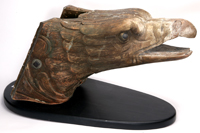 |
Late 18th Century Ship's Carved Eagle Figurehead. Stunning ship's handcarved wooden figurehead (14" x 27" x 12") in the form of the Federal Eagle, with open beak and scrolled shoulders. Forensic examination by Scientific Analysis of Fine Art, LLC (on file and available on request) of paint indicating piece predates the 19th century with restorations having been applied after the second decade of the 19th century. This remarkable figurehead was discovered in a barn in Bath, Maine. Museum grade mounting structurally supporting and mounted on a wood, tear-drop-shaped base and finished in black. A rare and extraordinary piece.
Buyer responsible for third party shipping. Call to make arrangements.
Estimated Value $20,000-UP.
Ex. The Claude Harkins Collection of Americana; Thomaston Auction Place Galleries, 8/25/12, lot 80.
View details and enlarged photos
| Realized
$2,400 |
Lot 472 |
 |
Handcarved Patriotic Shield From a U.S. Navy Frigate, c. 1812. Handcarved shield with 13 stars and 13 stripes, 43 x 33", hinged and carved to fit the stern of a ship. Thought to be from a c. 1812 ship operating on Lake Champlain. The shield was a gift from Mrs. Lila Webb at Shelburne Farms (located on Lake Champlain) to the Barbour family after they built White Birches Lodge at Follensby Pond in the Adirondack region in 1913.
This shield's bowsprit counterpart is in the Shelburne Museum collection. The shield is said to have been retouched in the early 20th century by noted artist Ogden Pleissner before he changed to watercolors in the 1930s.
The shield is accompanied by a scientific paint analysis report made by Jennifer L. Mass, Ph. D., director and senior scientist of Winterthur Museum. The report concludes that the paint compounds and layers are appropriate and correct for the age and history of this shield.
Buyer responsible for third party shipping. Call to make arrangements.
Estimated Value $15,000-UP.
Ex. The Claude Harkins Collection of Americana; Greg Caron,2007.
View details and enlarged photo
| Realized
$4,800 |
Lot 473 |
 |
Late 19th Century, Fine Giltwood Eagle Carving. Extra fine, handcarved displayed eagle 16½ x 47", perched on ribbon-tied, drape-and-oak-leaf wreath. Particularly heroic with exceptional detailing and craftsmanship. Removed from a Federal building in upstate New York. Condition is very good with some professionally restored surfaces. Impressive.
Buyer responsible for third party shipping. Call to make arrangements.
Estimated Value $3,000 - 5,000.
Ex. The Claude Harkins Collection of Americana; James Julia, 8/24/12, lot 2240.
View details and enlarged photo
| Realized
$2,400 |
Lot 474 |
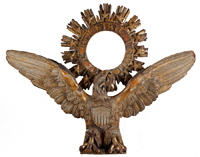 |
C. 1800s Federal Carved and Gilded American Eagle. Early 19th Century handcarved American eagle, 24" x 31" complete with shield at breast and beak supporting a circular bannerette inscribed, "E Pluribis Unum" detailed with rays and stars. Gilt has been worn to a warm, exceptionally-oxidized patina over the many decades. Evidence of repair to wing, and some scattered chipping commenserate with its age. In spite of the issues a very nice, and quite striking piece.
Buyer responsible for third party shipping. Call to make arrangements.
Estimated Value $2,000 - 3,000.
Ex. The Claude Harkins Collection of Americana; Freeman's, 11/13/12, lot 50.
View details and enlarged photo
| Realized
$480 |
Lot 475 |
 |
19th Century HandCarved Wall Eagle. Unusual hand-carved, wall-mounted, American eagle with shield on breast, 30" x 20", from the mid to late 1800s, likely from New Hampshire. In remarkable condition with usual wear and some minor chipping of original paint.
Buyer responsible for third party shipping. Call to make arrangements.
Estimated Value $2,000 - 3,000.
Ex. The Claude Harkins Collection of Americana; 4th of July Antiques, Sunnyvale, California, 12/1/12.
View details and enlarged photo
| Realized
$2,520 |
Lot 476 |
 |
19th Century Carved and Gilt Decorated Eagle. Unusual left-facing eagle, 13½" x 41", from the last quarter of the 19th century, clutching crossed arrows and boasting deeply detailed plumage. In overall fine condition with original painted and gilded surfaces; excellent patina with no breaks or losses to wood.
Buyer responsible for third party shipping. Call to make arrangements.
Estimated Value $1,500 - 2,000.
Ex. The Claude Harkins Collection of Americana; James Julia, 8/24/12, lot 2324.
View details and enlarged photo
| Realized
$930 |
Lot 477 |
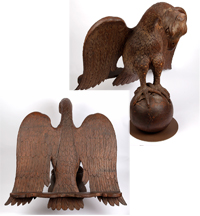 |
Late 18th-Early 19th Century Carved Eagle Lectern. Handcarved eagle in the Gothic style perched on an orb, the wings flattened and broad to form a lectern or bookrest, 30" x 26" x 18". Walnut, supported with metal base. Carved of individual pieces then fitted together. Eagle appears to be clutching in its talons a snake with the head missing; curl of tail repaired. Some splitting and filling of orb. Paint original and shows some wear. A similar example is in the Rochester (N.Y.) Art Gallery, most likely from the same artist. Refer to the "American Folk Art" book. A rare and striking piece.
Buyer responsible for third party shipping. Call to make arrangements.
Estimated Value $1,500 - 2,000.
Ex. The Claude Harkins Collection of Americana; Henry and Kay Goben, Overland Park, KS, 7/12/12.
View details and enlarged photo
| Realized
$360 |
Lot 478 |
 |
Carved Mahogany Plaque of the Great Seal of the United States. Late 19th century American carving, 12½" x 44" in rich, solid mahogany depicting an eagle with oak leaf and acorn wreath flanked on both sides with flowing banner. In very fine condition, no restoration or damage and mounted in a contemporary frame.
Buyer responsible for third party shipping. Call to make arrangements.
Estimated Value $800 - 1,200.
Ex. The Claude Harkins Collection of Americana; James Julia, 8/24/12, lot 2234; "Harp House," Camden, Main.
View details and enlarged photo
| Realized
$2,040 |
Lot 479 |
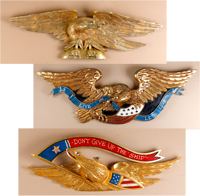 |
3 Carved American Eagles with Gold Gilt and Polychrome Paints. 3 pieces: Nice collection of carved pine wood, accurate reproductions of authentic Early American originals done in the tradition of fine craftsmanship using gilt and antiqued polychrome paints. "Live and Let Live, 13" x 28" x 9", "Don't Give Up The Ship" 10" x 28" x 4", Gilt Eagle 10.5" x 34" x 5". All in excellent condition ready to display.
Buyer responsible for third party shipping. Call to make arrangements.
Estimated Value $400 - 600.
Ex. The Claude Harkins Collection of Americana.
View details and enlarged photo
| Realized
$1,080 |
Lot 480 |
 |
Striking Wood Carving of Eagle. Fashioned by a single section of found wood, this handsome carved eagle 6.½" x 23" x 3½" demonstrates a high degree of craftsmanship, with dark polychrome paint and light varnish. Signed by artist J.P. Todd '85 on verso.
Buyer responsible for third party shipping. Call to make arrangements.
Estimated Value $250 - 300.
Ex. The Claude Harkins Collection of Americana.
View details and enlarged photo
| Realized
$160 |
Lot 481 |
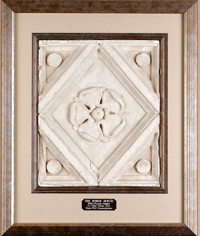 |
[The White House] 1902 Plaster Cornice. 12¾ x 10½" cornice from the first floor center hall, removed during the 1952 reconstruction. Framed to 20½ x 17¼". Weight is 8.32 oz.
A survey authorized by Congress in 1948 found much of the White House on the verge of collapse. Although it would have been cheaper to tear down the White House and build a new presidential residence, Truman realized the symbolic importance to the American people of the house first inhabited by John Adams and determined to keep the original structure intact. In December of 1948, President Truman moved across the street to Blair House, the official residence for visiting dignitaries. A multi-year renovation began that would cost $5.7 million. Much of the old interior of the was dismantled, but some of the existing interior detail was saved, such as this plaster cornice, which had been installed in 1902.
Buyer responsible for third party shipping. Call to make arrangements.
Estimated Value $600 - 800.
Ex. The Claude Harkins Collection of Americana; Butterfields, 6/29/2001; Fred T. Wright, an architect on The White House Renovation Commission of 1950.
View details and enlarged photo
| Realized
$566 |
Lot 482 |
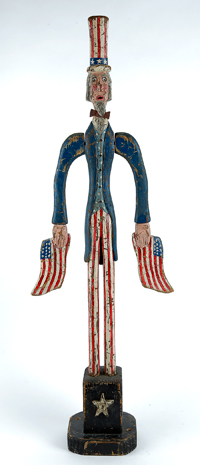 |
Handcarved Uncle Sam Folk Art. Charming, patriotic American folk art of Uncle Sam, hand-carved of wood and decorated in antiqued polychrome paints with arms that move at shoulders. With attached base, piece measures 31" x 6" x 5" and is in excellent condition. Probably early to mid 20th century.
Buyer responsible for third party shipping. Call to make arrangements.
Estimated Value $500 - 700.
Ex. The Claude Harkins Collection of Americana; Henry and Kay Goben, Overland Park, KS, 7/26/12.
View details and enlarged photo
| Realized
$1,107 |
Lot 483 |
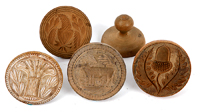 |
Antique Wooden Butter Stamps, Various Designs. Five items: Vintage original antique wooden butter stamps with turned handles, all approximately 3" x 4", boasting a variety of designs. Impressions include an acorn surrounded in oak leaves, a cow in front of a fence, a nicely-detailed bundle of wheat, and two with patriotic-themed eagles with shields. All stamps have smooth handles from use, yet reliefs remain in sharp condition. In very fine condition.
Estimated Value $400 - 600.
Ex. The Claude Harkins Collection of Americana.
View details and enlarged photo
| Realized
$246 |
Lot 484 |
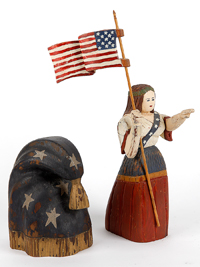 |
Hand Carved Wood Folk Art Pieces. Two pieces: Patriotic hand carved of wood folk art pieces. One a charming Standing Lady Liberty by Karen Rankin, carved from two blocks of wood, fused together, with left arm that articulates slightly and the rippling flag also carved of wood. Figure alone: 12 "x 6" x 4"; with flag: 17" high. Hand-carved Liberty Cap by S.R. White, 1994, 9" x 7" x 6". Both antiqued polychrome paint and toned oil finishes.
Estimated Value $250 - 350.
Ex. The Claude Harkins Collection of Americana;.
View details and enlarged photo
| Realized
$148 |
Lot 485 |
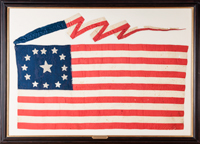 |
13 Star U.S. Constitution Ratification Parade Flag With Pennant Silk, c. 1788. Handsewn flag and pennant, both of silk. The flag is 18 x 35¾"; the pennant is 54" long and 2" wide. Framed dimensions are 30½ x 43". Made by an experienced sewer, likely a professional flag maker. The canton measures 9¾ x 12" and is made from a single piece of fabric, which is shattered, with pieces missing. The thirteen stripes, which alternate between red and white, are made of silk ribbon, none of which is pieced. Each ribbon is approximately 1 3/8" wide. Some staining to stripes. The stars are irregularly shaped and appear to have been cut by hand. A larger five-pointed star in the center is surrounded by twelve smaller five-pointed stars, all of which are appliquéd onto the canton with hand sewing. The fly is folded over to the reverse side of the flag for just under ¼ inch and sewn with white thread on the white stripes and red thread on the red stripes. The flag does not appear to have had a hoist but was likely attached to the pole by woven tapes that were sewn onto the flag on the hoist edge; sewing holes are visible in several locations which would be suitable for attaching tape ties. A forensic report by textile expert Dr. S. Rabbit Goody, is included.
While the Constitution was being voted on for ratification, many towns and cities put on events called "Federal Processions" to rally support for the new federal-style government and constitution. Ratification by nine of the thirteen states was required for the U.S. Constitution to be officially established, and on June 21, 1788, New Hampshire became the ninth state to ratify the Constitution, thus putting into effect the official Constitution of the United States.
The first eight states to ratify the Constitution were Delaware (Dec. 7, 1787), Pennsylvania (Dec. 12, 1787), New Jersey (Dec. 18, 1787), Georgia (Dec. 31, 1787), Connecticut (Jan. 9, 1788), Massachusetts (Feb. 6, 1788), Maryland (April 26, 1788), and South Carolina (May 23, 1788). New Hampshire was the deciding state on June 21, 1788, followed by Virginia on June 25, 1788, and New York on July 26, 1788. North Carolina (Nov. 29, 1789) and Rhode Island (May 29, 1790) were the last two states to ratify the Constitution.
Philadelphia held a spectacular July 4, 1788 Grand Federal Procession linking the U.S. Constitution with the celebration of the Declaration of Independence. It was the largest civic event the country had ever seen. Thousands of people attended and the parade covered three miles. Benjamin Franklin Bach, grandson of Benjamin Franklin, published a broadside listing the order of the procession. Alexander Reinagle, musician, wrote a Federal Grand March, and Francis Hopkinson, signer of the Declaration of Independence, wrote an ode. Famous artist Charles Wilson Peale provided flags of all of America's allies and aided in the design of costumes, banners, and mottos.
Hopkinson was also one of the principal planners and was instrumental in designing the Grand Federal Edifice, the centerpiece of the parade, which represented the Constitution. It was composed of a dome on 13 carved Corinthian pillars and beside it marched the 450 architects, carpenters, etc. who had built it. Thousands of craftsmen took part in the parade,bearing the tools of their trade. The bricklayers carried a banner which said, "Both Buildings and Rulers are the Works of our Hands." Ten ships in the harbor each flew a white flag at the masthead, spelling out in gold letters the name of one of the states which had ratified so far spelled out in gold letters.
On July 23, 1788, New York, which would not ratify the Constitution for another three days, held its own Federal Procession, and other cities such as Boston and Charleston held them as well. This flag would have been carried in one of these parades, amid great jubilation and patriotic pride.
Buyer responsible for third party shipping. Call to make arrangements.
Estimated Value $15,000-UP.
Ex. The Claude Harkins Collection of Americana; Ex Greg Caron, 2005.
View details and enlarged photo
| Realized
$31,200 |
Lot 486 |
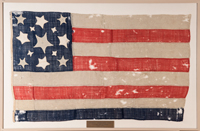 |
Whiskey Rebellion Flag, c. 1794. 13-Star, 8-Stripe Flag,completely handsewn, 23½ x 38"; framed: 28¼" x 43¼". There are four white stripes, three red, and one blue, all made of single-ply wool bunting. The canton is made of the same bunting as the bottom blue stripe.The 13 stars which are sewn onto the flag are appliqued to one side only of the canton.
Each star is handcut, somewhat irregular in shape and placed irregularly on the canton. One large five-pointed star is in the center of the canton and a smaller five-pointed star is in each of the four corners; all five are made of single-ply woolen cloth. The other four five-pointed stars are made of cotton fabric, as are the four smaller four-pointed stars. The eight stripes are irregularly pieced together; they vary from 2 inches to 3 5/8 inches in width. Single-ply linen thread was used on all parts of the flag, except for the cotton thread which was used to secure the cotton stars. A detailed report by textile expert S.R. Goody is available upon request.
The eight stripes represent the eight western counties of Pennsylvania which were involved in the rebellion against the excise tax on domestically-produced distilled spirits implemented by Treasury Secretary Alexander Hamilton in 1791 as a means to help retire the national debt. The primarily Scots-Irish farmers in Western Pennsylvania, many of whom were desperately poor, saw the tax as an assault on their liberty. They, in turn, assaulted the tax collectors, culminating in the burning of the home, barn, and slave quarters of the chief excise collector, John Neville, a former Revolutionary War general and childhood friend of George Washington. President Washington called out a militia of some 13,000 men and personally led them to Bedford, Pennsylvania,where he turned them over to General Henry "Light Horse" Lee. By the time the army arrived in Pittsburgh, the rebels had gone home. Approximately 150 men were arrested and tried for treason but lack of evidence and witnesses hampered the trials. Two men, John Mitchell and Philip Weigel, were found guilty of treason but were subsequently pardoned by President Washington.
Washington was determined to maintain the authority of the federal government and he was well aware of the mob rule taking place in Revolutionary France. He reminded Americans that they had freely chosen their Government and that "respect for its authority, compliance with its laws, acquiescence in its measures, are duties enjoined by the fundamental maxims of true liberty. The basis of our political systems is the right of the people to make and to alter their constitutions of government. But the constitution which at any time exists till changed by an explicit and authentic act of the whole people is sacredly obligatory upon all. The very idea of the people to establish government presupposes the duty of every individual to obey the established government…"
President Thomas Jefferson repealed the excise tax on whiskey by 1802.
Buyer responsible for third party shipping. Call to make arrangements.
Estimated Value $8,000 - 12,000.
Ex. The Claude Harkins Collection of Americana.
View details and enlarged photo
| Realized
$24,000 |
Lot 487 |
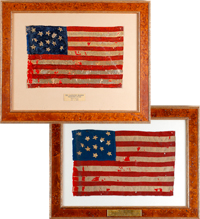 |
13 Star Flag - The Prisoner's Flag, c. 1781. Found in Devon England, this flag is believed to have been made by an American seaman captured during the Revolutionary War and held in an English prison. 8½ x 13½", handmade, of improvised material: silk and wool, with embroidered stars and white ribbons for the white stripes, appliquéd to a ground of red wool twill of very fine weave (an officer's redcoat?). The canton rests on the fourth red stripe, or "war stripe"; the stars are awkwardly patterned, possibly intended to delineate the crosses of St. George and St. Andrew or a semicircular arch. Accompanied by a report from textile expert Dr. S.R. Goody.
Betsy Ross' second and third husbands, Joseph Ashburn and John Claypoole, were both American seamen during the Revolutionary War. They were captured and were cellmates in The Old Mill Pond Prison in Plymouth, Devon Co. News of the British surrender at Yorktown (Oct. 17, 1781) reached the prison in late November or early December 1781 and one of the prisoners celebrated by making the "Stars & Stripes" and probably left it with one of the English families who kept the prisoners from starving. Joseph Ashburn, who was married to Betsy Ross at the time and was used to seeing her make flags, could well have been the one to make the flag, but this is speculation. Ashburn was in poor health and died on March 3, 1782 and John Claypoole married Betsy Ross upon his return to Philadelphia.
Accompanied by a painting of the flag made by Marie Mastai, July 4, 1970, with the exact dimensions of the original flag and housed in a matching 17 x 21" frame.
Buyer responsible for third party shipping. Call to make arrangements.
Estimated Value $7,500 - 10,000.
Ex. The Claude Harkins Collection of Americana; Sotheby's, Oct. 11, 2002, lot 80, Boleslaw and Marie-Louise d'Otrange Mastai Flag Collection.
View details and enlarged photo
| Realized
$39,360 |
Lot 488 |
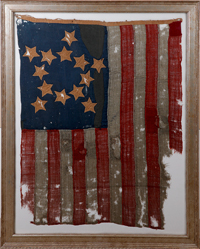 |
Great Star Pattern, Early 19th Century Flag. Handsewn "Great Star Pattern," constructed in the pattern of a 13-star National flag, 39¾ x 30"; framed: 46½ x 36½". The canton, which sits on the eighth stripe, is constructed of a blue wool twill fabric. The white cotton stars are arranged in a circle of eight with five stars irregularly positioned around the outside to suggest one large star. Stamped "Mastai Collection" on obverse inner star. The fly consists of 13 bunting stripes, alternating red and white, commencing and ending with red. Extensive damage and patching, evidence of extensive use. Definitely from the first quarter of the 19 century, possibly used during engagements and possibly during the War of 1812.
Accompanied by an analysis report and a treatment report by textile expert Fonda Thomsen.
Pictured in The Stars and the Stripes. The American Flag as Art and as History from the Birth of the Republic to the Present by Boleslaw and Marie-Louise D'Otrange Mastai.
Buyer responsible for third party shipping. Call to make arrangements.
Estimated Value $7,500 - 10,000.
Ex. The Claude Harkins Collection of Americana; Sotheby's, Oct. 10, 2002, Boleslaw and Marie-Louise d'Otrange Mastai Collection.
View details and enlarged photo
| Realized
$27,060 |
Lot 489 |
 |
13 Star Handsewn Flag After Pierre l'Enfant Design, Early 19th Century. A 13-star American National Flag from the first quarter of the 19th century. The flag is constructed of one layer of silk fabric. The blue silk canton measures 11¼" on the hoist and 14" on the fly and rests on the eighth (white) stripe. The 13 stars are applied with a gold pigment, possibly gold leaf, and are configured in an oval pattern. The fly consists of 13 red and white silk stripes that measure 1 3/8" to 1¾" in width on the obverse.Height: 21¼ x 33"; framed: 27 x 39".
In 1793, French architect and civil engineer, Pierre L'Enfant, who fought in the American Revolution and is best known for designing Washington, D.C., was asked to design the first membership certificate of the Society of the Cincinnati. His illustration included a flag bearing 13 stars in an oval pattern. This flag follows his design precisely.
This flag was loaned to the Society of the Cincinnati in 2003 and displayed at Anderson House in Washington, D.C. It is also pictured in The Stars and the Stripes by Boleslaw and Marie-Louise D'Otrange Mastai.
A textile analysis by Fonda Thomsen is included.
Buyer responsible for third party shipping. Call to make arrangements.
Estimated Value $6,000 - 8,000.
Ex. The Claude Harkins Collection of Americana; Sotheby's, Oct. 10, 2002, lot 51- Boleslaw and Marie-Louise d'Otrange Mastai Collection.
View details and enlarged photo
| Realized
$10,148 |
Lot 490 |
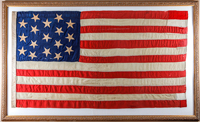 |
17-Star "False Colors" Flag From the CSS Shenandoah c. 1864-65. 39 x 70½"; framed: 48 x 81". Signed on the Hoist: "RI 8." There are several patches and holes on the flag and fabric replacement to fly end on the right side of the two upper stripes and the two bottom stripes.
The CSS Shenandoah was launched at Glasgow, Scotland in 1863 as the merchant ship Sea King, a state-of-the-art clipper for the China tea trade. An iron-framed, teak-planked, full-rigged ship, with auxiliary steam power, she was bought by the Confederate States of America, which sorely needed ships, and sailed out of Liverpool under false papers on Oct. 8, 1864, captained by CS Navy Lieutenant Commanding James Waddell. She became one of the most feared commerce raiders in the Confederate Navy. She carried four 8-inch ("68 pounder") smoothbore cannon, two rifled Whitworth 32-pounders and two 12-pounder signal guns. She never engaged any U.S. Navy vessels, her prey being unarmed merchant ships. During a 12½ month period in 1864-65, during the course of a 58,000-mile cruise, she captured 38 ships and burned 32, taking over a thousand prisoners, not one of whom was killed. Prizes that were not burned were packed with prisoners and sent into neutral ports. The CSS Shenandoah fired the last shot of the American Civil War, at a whaler in waters off the Aleutian Islands. Her battle ensign was the only Confederate flag to circumnavigate the globe during the Confederacy, and was the last Confederate flag to be lowered by a combatant unit in the Civil War when she surrendered on November 6, 1865, in Liverpool, England.
When a ship flies a "false colors" flag, it is using the flag of another country for a deceitful purpose, normally to allow it to get close enough to board and capture the ship; it is a ploy that has been used by pirates throughout the ages. Such was the purpose of this flag, sewn by the sailors on the Confederate ship CSS Shenandoah. They filled the blue canton with 17 stars, which, from a distance, would resemble a Union flag. In fact, Ohio was the 17th state to join the Union in 1803 and there never was a Union flag with 17 stars; it went from 15 stars (1795-1817) to 20 stars (1817-1818), and by the beginning of the Civil War, there were 34 states in the Union (West Virginia would be admitted in 1863 and Nevada in 1864); however, seeing this flag waving in the breeze from far away, a whaling ship, which carried no guns, would not think to count the stars. Our research found that it is not illegal for a ship to fly false colors as long as the proper flag is hoisted before the ship fires a shot.
Who knows how many of the ships she captured were lured closer by this flag? Although the South lost the war, the CSS Shenandoah was successful in her purpose: she single-handedly decimated the whaling oil industry.
Buyer responsible for third party shipping. Call to make arrangements.
Estimated Value $5,000 - 7,500.
Ex. The Claude Harkins Collection of Americana; purchased in the early 1990s from a small New England auction.
View details and enlarged photo
| Realized
$8,610 |
Lot 491 |
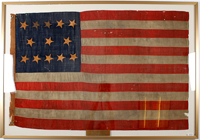 |
13 Star Centennial Flag, Philadelphia, 1876. 1876 Centennial flag, 13 Star Flag in very rare 5-3-5 star pattern, with 13 stripes. Wool bunting, machine sewn, 34 x 53 in.; framed to 41¼ x 58½" The two painted-over stars are a mystery. Perhaps the family who owned it lost two sons to war.
Purchased from Monroe Post No. 87 American Legion, Ohio. The maker was Thomas Coulson, a weaver in Philadelphia in 1876. The flag descended through seven generations of the Coulson family from Philadelphia.
A copy of textile expert Dr. S.R. Goody's forensic report accompanies the flag.
Buyer responsible for third party shipping. Call to make arrangements.
Estimated Value $3,000 - 5,000.
Ex. The Claude Harkins Collection of Americana.
View details and enlarged photo
| Realized
$7,500 |
Lot 492 |
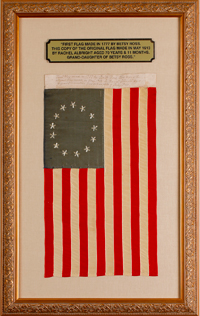 |
13 Star Flag Made by the Granddaughter of Betsy Ross. Handsewn silk flag with 13 embroidered stars in blue canton at upper right, 8¼ x 14¾"; housed in a period frame, 11½x 18". Inscribed on the hoist: "First Flag made in 1777 by Betsy Ross. This copy of the original Flag made in May 1913 by Rachel Albright aged 70 years and 11 months, Grand-daughter of Betsy Ross."
Buyer responsible for third party shipping. Call to make arrangements.
Estimated Value $2,000 - 3,000.
Ex. The Claude Harkins Collection of Americana; Cowan's Auctions, Inc., 12/7/2012, Lot 13.
View details and enlarged photo
| Realized
$3,075 |
Lot 493 |
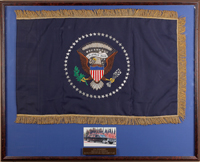 |
Nixon, Richard M. - Presidential Limousine Flag. Vintage flag from the Nixon Administration, one of those used on his Lehmann-Peterson-built limo now on display at the Nixon Library in Yorba Linda. Fringed with gold and silver bullion stars on dark blue field, measuring 19¾ x 33". In excellent condition and archivally mounted above a photograph of the 1969 limo and preserved within a 33½ x 41¾" frame. Accompanied by a copy of a letter from the man who purchased the flag from a U.S. Marine who served in the White House.
Buyer responsible for third party shipping. Call to make arrangements.
Estimated Value $600 - 900.
Ex. The Claude Harkins Collection of Americana.
View details and enlarged photo
| Realized
$2,520 |
Lot 494 |
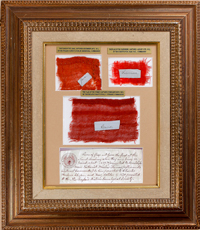 |
Pieces of Flags From Three Ships Captured by the USS Constitution. Small fragments of three flags, as follows:
A 2 x 2½ inch fragment of the flag of the HMS Guerriere, a 38-gun frigate which the British had captured from the French in 1806, commanded by James Richard Dacres, captured on Aug. 10, 1812, 400 miles SE of Halifax, Nova Scotia, by the USS Constitution, commanded by Isaac Hull.
A 2¾ x 3¼ inch fragment of the flag of the HMS Java, a Pallas class frigate, commanded by Henry Lambert, captured on Dec. 29, 1812 off the coast of Brazil after its engagement with the USS Constitution, commanded by William Bainbridge.
A 3¼ x 5¼ inch fragment of the flag of the HMS Cyane, a 22-gun Banterer-class sixth-rate post ship built in 1806, commanded by Gordon Thomas Falcon, captured along with HMS Levant approximately 100 miles east of Madeira by USS Constitution, commanded by Charles Stewart.
The fragments are matted together with a note from the New England Historic-Genealogical Society: "Pieces of flags cut from the flags at the Naval Academy when they were being repaired, about 1859, & presented to midshipman Nathaniel Winslow Thomas (afterwards Lieutenant Commander) by him presented to Charles Frederic Sleeper, and now, October 13, 1870 presented to the New England Historic-Genealogical Society." Housed in a gilt 18 x 15¾" frame.
Estimated Value $400 - 600.
Ex. The Claude Harkins Collection of Americana.
View details and enlarged photo
| Realized
$3,480 |
Lot 495 |
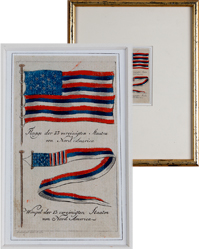 |
First Published Appearance of the American Flag, 1783. From the German almanac, "Historisch Genealogischer Calender Oder Jahrbuch," published by Haude and Spener, Berlin, 1783. The engraving is one of twelve copper plates accompanying an article by Professor Matthias Sprengel of the University of Halle, illustrating incidents in the American Revolution. This engraving, considered the first accurate published view of the Stars and Stripes, shows the flag with 13 red, blue, and white stripes in sequence, so that the first and last stripes are red. The stars are five-pointed, arranged in a 3-2-3-2-3 pattern, and are painted in black on the blue canton. A similar design appears in the pennant. Sheet is 3¾ x 2¼"; rag matted in a gilt frame to 11½ x 9".
Estimated Value $900 - 1,200.
Ex. The Claude Harkins Collection of Americana; Thomaston Place Auctions Galleries, Inc., 11/6/2012; Marvin Sadik Collection.
View details and enlarged photo
| Realized
$870 |
Lot 496 |
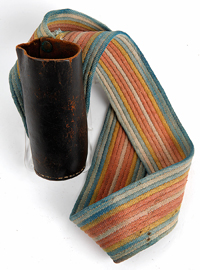 |
Civil War Era Flag Carrier. Cotton and leather flag carrier. Strap: 22" long and 3" wide strap; leather cup: 6½ x 3 x 3". In overall very good condition with minor fraying around top brad.
Estimated Value $150 - 200.
Ex. The Claude Harkins Collection of Americana;.
View details and enlarged photo
| Realized
$90 |
Lot 497 |
 |
Powder Horn - Siege of Boston, 1776. With scrimshaw inscription: "THE GIFT OF DAVID NILES TO MR. DAVID WHEELER 1776" and below: "LIBERTY OR DEATH," approximately 11". Both Niles and Wheeler served in the 6th Conn. Regt. at Roxbury in 1775. The horn also bears an engraved view of Roxbury camp with cannon firing, with seaweed and fish borders at spout and plug ends. The name "BARZILLA SMITH" is engraved over a ship; Smith was commander of the privateer schooner "Eagle" in 1776.
This horn is attributed to James Greenfield, who was one of the most significant identified carvers of the period and who carved horns for men who served in his company during the 1775-1776 campaign at Boston; it was commissioned by David Niles for David Wheeler. Niles is known to have served in Connecticut 3rd Co., 6th Regt. and to have been at Camp Roxbury for seven months during the Siege of Boston.
This powder horn was on loan to the Hoover Presidential Library & Museum in West Branch, Iowa in 2002 as part of an exhibit entitled "Revolutionary America 1763-1783" and at the Cambridge Historical Society Museum in 2008.
Estimated Value $10,000 - 15,000.
Ex. The Claude Harkins Collection of Americana; Guthman Americana, 1993.
View details and enlarged photo
| Realized
$20,400 |
Lot 498 |
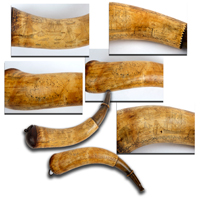 |
Powder Horn - Independence Day, 1777, With Early Artistic Rendering of Stars and Stripes. Nautical horn, 13¼", with scrimshaw inscription "Augustus S[a]unders 1777"; other etchings on the horn include intricate miniatures of warships and other vessels in Philadelphia's harbor for the July 4, 1777 Inpendence Day celebration, as well as other scenes from the event. Ships carved on the powder horn include the frigate Delaware, the top sail sloop Sachern, the frigate Montgomery, the schooner Fly, the xebec Repulse, the sloop Race Horse, the brig Andrea Doria, the sloop Surprise, a half galley with sail, a row galley, and a top sail sloop. The frigate Delaware is flying two crudely-etched flags bearing the Stars and Stripes design adopted by Congress three weeks earlier on June 14, 1777; these are possibly the earliest artistic representations of the original Stars and Stripes. Of interest is the fact that in May of 1777, Betsy Ross signed a contract with the Pennsylvania Navy to make flags. The flag flying from the Delaware could well have been taken from Betsy Ross' design. Also engraved on the horn are a freedom fighter, probably Private Augustus Saunders, with his musket over his shoulder; a mermaid; and a rendering of Philadelphia's Christ Church sprouting the Tree of Liberty.
John Hancock and John Adams boarded the Delaware during the Independence Day celebration. All of the ships present at the celebration except the Delaware were scuttled as the British closed in on Philadelphia in late 1777, and she was commandeered by the Royal Navy.
This powder horn was featured in the August 2010 issue of the magazine "American History," pp 16-17. A historic and unique powder horn.
Estimated Value $10,000 - 15,000.
Ex. The Claude Harkins Collection of Americana; Guthman Americana, 1993.
View details and enlarged photo
| Realized
$13,200 |
Lot 499 |
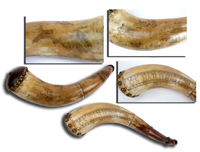 |
Powder Horn - With Name of Caleb Harrington, Killed in the Battle of Lexington. Historic 18th century powder horn, approximately 13 inches long, adorned with the name "C[aleb] S Harrington," one of eight Americans killed at the Battle of Lexington on April 19, 1775, engraved within a decorative border. Pictured above Harrington's name and around the horn are a portrait of Lexington, Massachusetts, a flying angel with a trumpet, two cherubim holding a banner with the words "Sons of Liberty," and an early representation of an American eagle with wings spread. An extremely rare and desirable relic related to the first Battle of the American Revolution.
Estimated Value $5,000 - 6,000.
Ex. The Claude Harkins Collection of Americana; Bruce Gimelson.
View details and enlarged photo
| Realized
$6,900 |
Lot 500 |
 |
Powder Horn of Col. Peter Van Ness, 9th Regt. Albany, NY Militia. Deeply-carved scrimshaw inscription: "Col. Peter Van Ness" and diagonally: "9th Regt. Alb.y Co. N.Y. Ma. 1780." Also, beautiful carvings of a view of the harbor of New York, a forest, a large carving of a militia soldier, an Indian holding a tomahawk and a flintlock rifle, Lake George, a small map of the Hudson and Mohawk rivers, noting Fort Hunter, Half Moon, and Saratoga, and a carving of Col. Van Ness astride his horse with upraised sword, as well as the initials "PV". Approximately 10½".
Accompanied by documents researched by a former owner regarding the service of Peter Van Ness (1734-1804) and his public life. He is listed in the Colonial History of the State of New York, the National Archives of the Daughters of the American Revolution, etc. In October 1775 Van Ness was appointed Colonel in command of the 9th Albany County militia regiment (2nd Claverack battalion); he was re-appointed in May 1778. According to Documents Relating to the Colonial History of the State of New York (edited by Berthold Fernow, Vol. XV, State Archives, Vol. I, 1887), Van Ness begged leave to resign in October 1780 because "he considers himself unjustly treated in point of rank by the promotion of Colonel Robert Van Rensselaer." Since the horn is dated 1780, it was likely carved and presented to Van Ness by his troops when he resigned.
The inscription on Van Ness' grave, at Lindenwald in the town of Kinderhook, N.Y., states his command of the company, as well as the information that he was in command of a regiment at the surrender of Burgoyne in 1777, that he was a member of the State Convention that adopted the Federal Constitution, that he served as a state senator, was a member of the Council of Appointment, and was the chief judge of Columbia County.
Powder horns of high-ranking officers are rare.
Estimated Value $4,000 - 6,000.
Ex. The Claude Harkins Collection of Americana; Frank Murphy, Massapequa Park, NY, 1992.
View details and enlarged photo
| Realized
$4,320 |
Lot 501 |
 |
Powder Horn - Haddam Connecticut, 1776. With scrimshaw inscription: "Isaac Thomas His Horn Haddam Connecticut--Cap. Pecks Company 5th Battalion Dec 25, 1776"; 13" long. Drawings include a figure of an Indian holding a peafowl on a string, another plumed bird, beavers cutting down a tree, a four-legged animal (a deer?), a half figure of a man or woman, geometric designs, etc. On the wooden bottom is a later engraving: "WB 1788." This horn is listed on page 70 of "American Powder Horns," The Metropolitain Museum of Art, item 847.
Captain Peck's Company, 5th Battalion, Wadsworth's Brigade, under Col. Douglas, was raised June 1776 to reinforce Washington's army at New York. It served in the city and Brooklyn; it was at the right of the line of works during the battle of Long Island on Aug. 27th. It engaged in the retreat to New York Aug. 29-30, was stationed with militia brigade at Kips Bay, 34th St., on the East River, at the time of the British attack on New York, Sept. 15th and was forced to retreat hurriedly. Peck's Company also took part in the battle of White Plains, Oct. 28. The enlistment term expired Dec. 25, 1776.
Estimated Value $2,000 - 3,000.
Ex. The Claude Harkins Collection of Americana; Hyde Park Country Auctions, May 5, 2005.
View details and enlarged photo
| Realized
$3,720 |
Lot 502 |
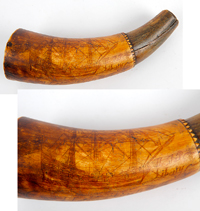 |
Powder Horn Depicting the Three-Masted Ship Liberty, 1775. With a large detailed scrimshaw engraving of the Liberty; to the right is "II Ship Liberty" and below is "Capt. John King's Horn 1775"; 9" in length.
The USS Liberty was one of the Continental armed vessels on Lake Champlain. She was a schooner, armed with two four-pounders, four two-pounders and eight swivels, and she supported the Continental forces during the Canadian campaign. Built at Skenesboro (now Whitehall) on Lake Champlain, New York for wealthy landowner and former British Army Captain Philip Skene, she was captured on May 11, 1775, and renamed Liberty.
Vol. II, p. 87 of Naval Documents of the American Revolution (William Bell Clark, editor, 1966) gives the General Order of Major General Philip Schuyler, Camp at Isle aux Noix, Sept. 13, 1775, "The Schooner 'Liberty' will proceed with the Army--Capt Douglas & Lt. Lockwood will chuse out determined Volunteer Crew and good Rowers for the Gallies." In one of the first naval battles of the American Revolution, American commander Benedict Arnold (not yet a traitor) lost many of his ships during the battle of Valcour Island (Oct. 11, 1776). The Liberty, which was away on a supply run, escaped the fate of most of Arnold's fleet, but she was destroyed in June 1777 as Burgoyne marched south.
Estimated Value $2,000 - 3,000.
Ex. The Claude Harkins Collection of Americana; Guthman Americana, 1993.
View details and enlarged photo
| Realized
$4,800 |
Lot 503 |
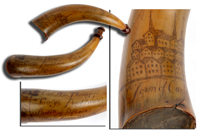 |
Powder Horn - Carlisle, Pa. Battalion of Riflemen, 1775. Scrimshaw inscription: "Col. Wm. Thompson / Carlisle, Pennsylvania / Battn of Riflemen / Made June ye 25 1775"; "Town of Carlisle" is just above the plug. The horn also bears a depiction of a large town with three churches, a bird, a trailing vine, and a pot of flowers. William Thompson was a brigadier general in the Continental Army. He was appointed Colonel of a rifle battalion in 1775 and sent to Massachusetts to help in the defense of Boston. His unit was known as "Thompson's Pennsylvania Rifle Battalion." Approximate size: 13". Horn at butt plug end with break and staple repair, otherwise very good.
Estimated Value $750 - 1,000.
Ex. The Claude Harkins Collection of Americana.
View details and enlarged photo
| Realized
$1,260 |
Lot 504 |
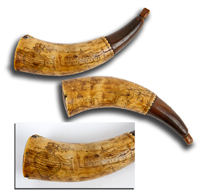 |
Priming Horn With An Alligator and Double-Headed Hessian Eagle. Revolutionary War era, of probable southern provenance, with scrimshaw engravings of an alligator, what appears to be a Spanish Mission, a large and a small sailing ship, a large trailing, flowering vine, a man, a double-headed Hessian eagle, a mermaid, a small alligator or fish, etc. Approximately 7". The only Hessian settlement in the south at that time was the Salzburger colony on Saint Simons Island just off the coast of Savannah, Georgia. Some chipping around butt plug.
We use the generic term "Hessian" to refer to the 30,000 German soldiers hired by George III to fight with the British during the American Revolution; however, some Germans fought in the Continental Army, and over 6,000 of the Hessians hired by the British deserted and stayed behind to live in the new republic.
Estimated Value $600 - 800.
Ex. The Claude Harkins Collection of Americana.
View details and enlarged photo
| Realized
$480 |
Lot 505 |
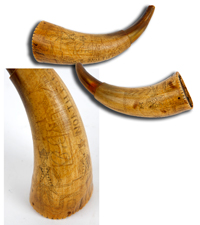 |
Priming Horn, Massachusetts Militia, 1776. With scrimshaw inscription: B[RI]G[ADE] 7 EAGER / MASS. MILITIA / 1776. On the other side are several buildings with NORTHBORO below. BE, probably the initials of the carver are at left; those initials are also carved on the plug. Three soldiers in uniform wear tricorn hats; they carry muskets with bayonets attached. Approximately 6".
Estimated Value $500 - 600.
Ex. The Claude Harkins Collection of Americana.
View details and enlarged photo
| Realized
$2,340 |
Lot 506 |
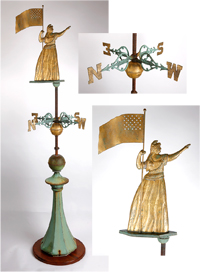 |
19th Century Goddess of Liberty Copper Weathervane. Remarkable molded copper-and-zinc weathervane from the second half of the 19th Century and attributed to Cushing and White, based on a design by A.L. Jewell, Waltham, MA. Characteristics of Jewell/Cushing & White vanes include asymmetrical rows of stars; a gown with a fringed girdle, rather than a toga-like drape; the absence of a mantle; and a laurel wreath as well as a liberty cap on the head, all attributes of this weathervane. Modeled with an American flag with 32 pierced stars, Liberty is rendered in exceptional detail and is joined to a copper hexagonal plinth above a copper ball. Rod-mounted with scrolled brass directionals with oxidized green patina and all mounted to an octagonal copper base with a green surface patina. Liberty measures 20¾" tall, and the overall height is 69¼". In very good condition with old surfaces. A stunning piece.
Buyer responsible for third party shipping. Call to make arrangements.
Estimated Value $15,000-UP.
Ex. The Claude Harkins Collection of Americana; James Julia auction, 8/24/12, lot 2136; a private Maine collection.
View details and enlarged photo
| Realized
$18,000 |
Lot 507 |
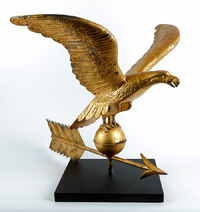 |
Molded Copper and Gilt American Eagle Weathervane. First quarter 20th century copper weathervane, 21" in height; 24" wingspan. Eagle perched with talons clinched, on a mid-banded ball joined to an arrow with sheet copper feathers. Modern stand. Piece retains much of its original gilded surfaces with minor loss to edges of wings and to back of neck, which also has a small dent and very minor imperfections from normal weathering.
Buyer responsible for third party shipping. Call to make arrangements.
Estimated Value $2,000 - 3,000.
Ex. The Claude Harkins Collection of Americana; James Julia, 2/5/10, lot 2208.
View details and enlarged photo
| Realized
$1,620 |
Lot 508 |
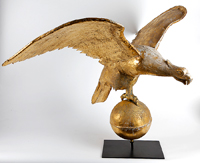 |
Large Gilt Metal Eagle Weathervane, Late 18th or Early 19th Century. Striking and patriotic gilt metal and cast zinc eagle on sphere weathervane: 38" wingspan, 27¾" height, and 26½" depth, with gilt finish on custom base 1" x 24". Possibly A.L. Jewell & Co., or the Boston Metal Workers Co. A similar form of eagle weathervane is illustrated in A Gallery of American Weathervanes and Whirligigs by Bishop and Coblentz, p. 51, figure 78. Many weathervanes were made to custom order and cannot be categorized specifically to a certain manufacturer. Refer to Yankee Weathervanes by Myrna Kaye, chapter titled "The Weathervane Industry," p. 143Normal oxidation to finish and areas of wear typical from outside use, which has given the piece a most appealing patina.
Buyer responsible for third party shipping. Call to make arrangements.
Estimated Value $1,250 - 1,500.
Ex. The Claude Harkins Collection of Americana; Henry and Kay Goben, Overland Park, KS, 7/12/12.
View details and enlarged photo
| Realized
$1,138 |
Lot 509 |
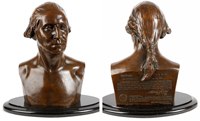 |
Extraordinary Bronze Bust of George Washington. James Wilson Alexander MacDonald (1824-1908) sculpture of George Washington, 19½" x 11¾" x 8½" on marble base. Sculpture on verso is elegantly stamped with full text of COA and artist's signature which certifies bronze a perfect reproduction of Washinton's life-cast and copyrighted 1898 by the Henry-Bonnard Bronze Co. Founders, New York. Bust is of bronze, with a dark brown patina, custom-beveled marble base measures 2" x 20" x 12". Combined weight approxiamately 40 pounds. In excellent condition.
Estimated Value $1,500 - 2,500.
Ex. The Claude Harkins Collection of Americana.
View details and enlarged photo
| Realized
$2,400 |
Lot 510 |
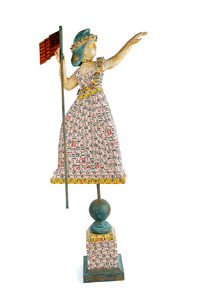 |
Standing Lady Liberty Folk Art Sculpture. Charming 20th Century standing Lady Liberty (29" x 8" x 2") on ball and pedestal including carved figure, pedestal, flag, star sash and garland ornamented with antiqued polychrome paints and strips of glued, vintage cloth seamstress's measuring tape. Missing tip to one extended finger; otherwise fine.
Buyer responsible for third party shipping. Call to make arrangements.
Estimated Value $1,000 - 1,500.
Ex. The Claude Harkins Collection of Americana; Thomaston Place Auctions Gallerlies, 8/31/08, lot 687.
View details and enlarged photo
| Unsold |
Lot 511 |
 |
Rare 19th Century Pennsylvania Dutch Feather Bed Smoother. A singularly unique, hand-fashioned tool of days long past. A beautiful 19th century carved and painted Pennsylvania Dutch feather bed smoother, ¾" x 32½" x 4½". After plumping and beating a feather bed to loosen dust and the like from a mattress, a smoother was used to tame lumps into a smooth comfortable sleep. Commonly hand-made in a variety of styles, this example demonstrates the craftsmanship of the Pennsylvania Dutch community with lovely, hand-carved details of a scalloped edge design, pin wheels, star bursts, some numbers and the initials J. K. T. Remnants of a deep ox-blood paint remain. Highly collectible and in quite fine condition.
Estimated Value $1,000 - 2,000.
Ex. The Claude Harkins Collection of Americana.
View details and enlarged photo
| Realized
$600 |
Lot 512 |
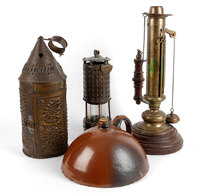 |
Assorted Antiques from the 19th and Early 20th Century. Four vintage original items: (1) 19th century brass candle stick, 16" x 17" with one-hour marks, weight and original wood base and handle, in good condition with wear commenserate to age (2) Brass coal miner's Koehler Permissible Safety Lamp, Koehler Mfg. Company, 10" x 4" x 4" in very good condition, typical evidence of use (3) Rare and enormously appealing flat-bottom, half-dome stoneware ship's crock, 5" x 9" x 9" with reddish brown Albany slip glaze, applied handle with a decorative incised line below spout and cork. Bottom bears the expected "wired off" pattern of oblong concentric rings. (4) Punched/pierced candle lantern in a traditional sunburst design, 13½" x 5¼" x 5¼", found in Duxbury, Mass. in appealing, used condition given its years. Clamped candle stick holder inside lantern still intact. All nice pieces.
Estimated Value $600 - 800.
Ex. The Claude Harkins Collection of Americana.
View details and enlarged photo
| Realized
$348 |
Lot 513 |
 |
Large, Rare George Washington Liverpool Jug, 1790s. George Washington Creamware Liverpool Jug, c. 1790s, 10½" x 7", with black transfer art of George Washington surrounded by a cartouche of the 15 states of the time. On the reverse is a poem praising Washington. Pitcher has had expert restoration to spout and handle, conservation to a 5½" crack to keep in check on spout side of jug, and wear to gilt ornamentation. In spite of these issues, this 220+ year old jug has very nice eye appeal.
Estimated Value $500 - 700.
Ex. The Claude Harkins Collection of Americana.
View details and enlarged photo
| Realized
$600 |
Lot 514 |
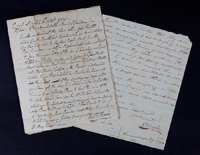 |
[Whiskey Rebellion] Two Letters: One From Each Side. Two autograph letters written during the Rebellion:
(1) A 2-page letter by rebel G. Fisher, 8 x 6 3/4", Harrisburg [Pennsylvania], July 5, 1794, reporting to John Glossinger that "Drummer & fifes of my company of Light Infantry at 4 oclock yester Morning paraded completely acquiped & with the Genuine ardour of Freeman agreed unanimously to march at a moments warnhing, in Defence of their Rights, Liberty & Property…." (2) A one-page letter, 8 x 6 3/4", Camp at Carlile, Oct. 11, 1794, written by William Harris of Chester County, Pennsylvania, who was marching through southern Pennsylvania trying to catch up with President Washington's main army. He informs his wife, "Unfortunately we arrived about One Our two Late to see our troops march from this place," but he expects to overtake them the next day in Shippensburg, "We expect we shall not stop short of Bedford, as the President is Determined to Listen to no Proposals till he Marches his Army into the midst of there country." On the address leaf below his wife's address, he wrote, "Sign of Genl. Washington." Both letters toned.
In 1791, when Treasury Secretary Alexander Hamilton placed an excise tax on whiskey in order to help fund the new nation's large national debt, farmers in western Pennsylvania suffered the most from the tax burden and many refused to pay. The situation deteriorated and in July 1794, farmers attacked the home of the Pennsylvania tax inspector. President Washington personally led a force of some 13,000 militia to put down the resistance, but by the time he arrived, the rebels had disappeared and order was restored. The tax was repealed President Thomas Jefferson in 1802. [See the Whiskey Rebellion flag in this section].
Estimated Value $400 - 600.
Ex. The Claude Harkins Collection of Americana.
View details and enlarged photo
| Realized
$320 |
Lot 515 |
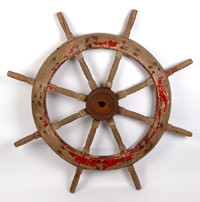 |
19th Century Ship's Wheel With Original Paint Remnants. Antique eight-spoke ship's wheel likely from the mid to late 1800s. Measures 34" tip to tip with iron hub 5½" x 2" x 2". Appears to have been painted three different times over the course of its considerable years, in oxblood, blue, and red, with paint remnants still visible. Nice rustic appeal, weight approximately 20 pounds.
Buyer responsible for third party shipping. Call to make arrangements.
Estimated Value $250 - 350.
Ex. The Claude Harkins Collection of Americana.
View details and enlarged photo
| Realized
$240 |
Lot 516 |
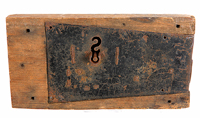 |
[Battle of Bennington] Historic Partial Door and Lock, 1777. A relic, 6½" x 12" x 2" from the Battle of Bennington, which took place on Aug. 16, 1777 and was part of the Saratoga campaign. General John Stark, reinforced by men led by Colonel Seth Warner and members of the Green Mountain Boys, defeated a detachment of Burgoyne's army, led by Lieutenant Colonel Friedrich Baum, which had been sent to raid Bennington for horses, draft animals, and other supplies. Some of those supplies were secured by this partial door and lock, which definitely exhibits its age with wood square nail holes in evidence. It was later used in a cabin in Pownal, Vermont. Its story is spelled out on the back of the piece.
The American victory at Bennington was a decisive one, reducing Burgoyne's army in size by almost 1,000 men, and depriving him of much-needed supplies; additionally, his Indian support largely abandoned him. Burgoyne's eventual surrender at Saratoga was a huge psychological victory as well, galvanizing colonial support for independence and bringing France into the war on the American side.
Estimated Value $250 - 300.
Ex. The Claude Harkins Collection of Americana.
View details and enlarged photo
| Realized
$258 |
Lot 517 |
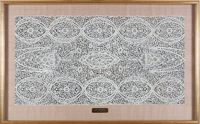 |
[Washington, Martha] Handmade Brussels Lace Riding Veil. Original handmade riding veil used by Martha Washington at Mount Vernon, 19 x 96 in., folded in frame (44 x 26 in.). The veil is constructed of homemade, cream-colored Brussels net lace. The long, rectangular panel features a design of oval shapes surrounding a simple center medallion (on a net ground) flanked by secondary medallions (on a net ground) and elliptical forms on a ground of dense lace patterns. The oval designs and medallion are defined by double rows of hedebows (the circular buttonhole designs). The edge of the panel is trimmed in picots.
This veil was first sold in February 1917 at Stan V. Henkels in Philadelphia, Catalogue No. 1186, Lot 5. The sale was called "The Great Historical Sale," and included "Relics of George and Martha Washington and of James Monroe Belonging to Mrs. Hortense Monroe McIntire Including Lady Washington's and Mrs. Monroe's Laces and Dresses" (photocopy of title page, explanatory page, and two pages containing first seven lots). This veil was sold again at Christie's on 17 November 1941, lot 276 (photocopy of catalogue page included), and then at Alderfer's (in Philadelphia) on 28 September, 2001, lot 870 (photocopy of catalogue page included). In the 1941 Christie's sale, the two lots before this veil (lot 276) were the veil that Martha wore in the famous Gilbert Stuart painting that hangs in the White House alongside the Lansdowne portrait of Washington (lot 274) and Martha's wedding veil (lot 275).
Mrs. Hortense Monroe McIntire was the great-great-granddaughter of James Monroe, whose mother was the youngest daughter of Lloyd N. Rogers and Miss Hortensia Hay, a granddaughter of President James Monroe. When James Monroe was Minister to France, his daughter went to school in Paris and while studying under the famous Mme. Campan, formed a friendship with Hortense Beauharnais, daughter of Empress Josephine by her first husband. The friendship was kept up and Monroe's daughter, who had married Judge Hay, named her daughter Hortensia after Hortense, who was Queen of Holland at the time and who became godmother to Hortensia. Hortensia's granddaughter, Hortense Monroe McIntire, received this veil and other Washington relics from her grandmother. A branch of the Rogers family (mentioned above) married into the Washington family.
Buyer responsible for third party shipping. Call to make arrangements.
Estimated Value $4,000 - 6,000.
Ex. The Claude Harkins Collection of Americana.
View details and enlarged photo
| Realized
$2,400 |
|
|